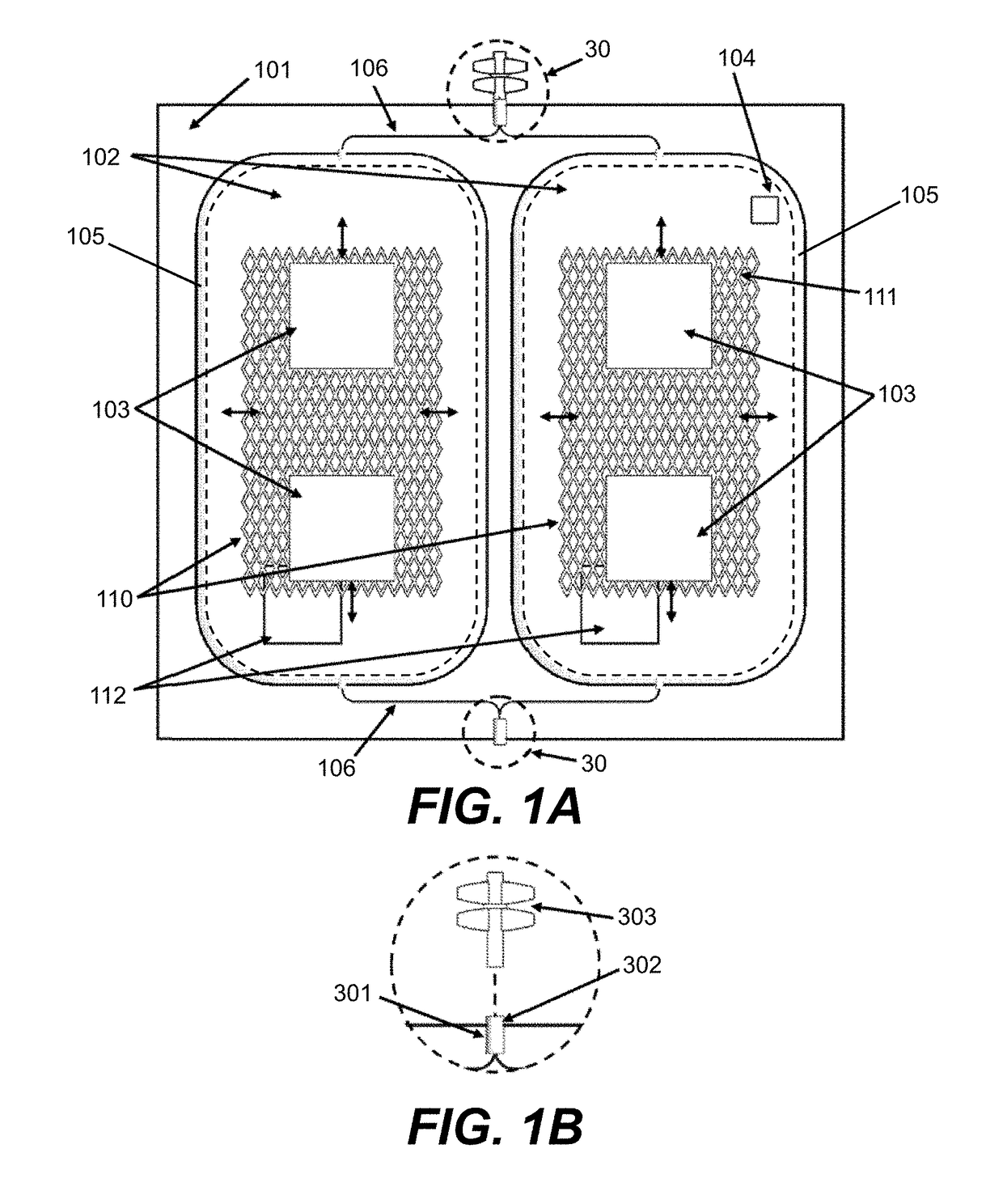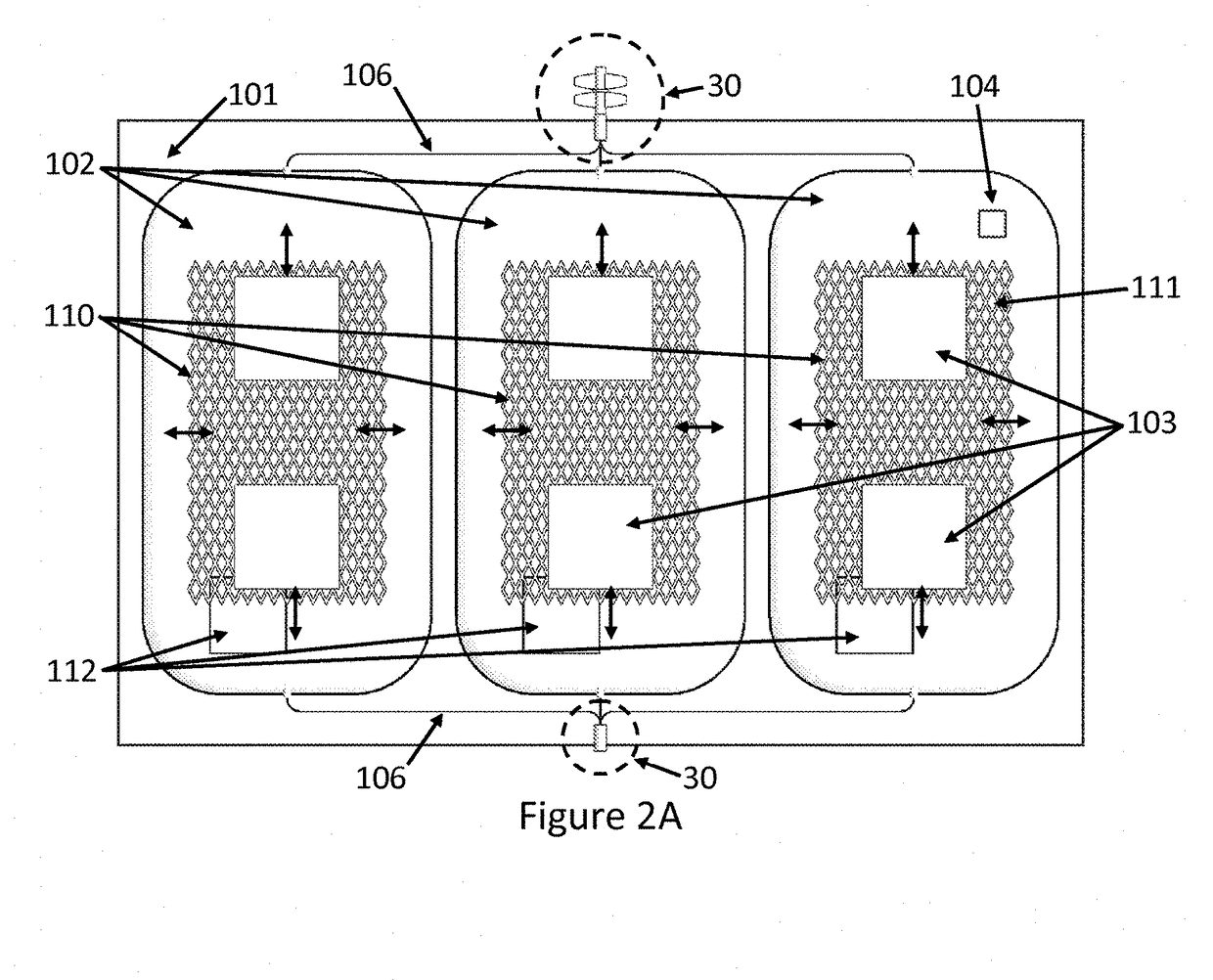Oxygen reduction disposable kits, devices and methods of use thereof
a technology of disposable kits and oxygen, applied in the field of oxygen reduction disposable kits, can solve the problems of reducing the quality of stored rbcs, and reducing the possibility of toxic effects
- Summary
- Abstract
- Description
- Claims
- Application Information
AI Technical Summary
Benefits of technology
Problems solved by technology
Method used
Image
Examples
example 1
Fabrication of Outer Receptacle 101
[0264]A barrier bag is fabricated by heat sealing along one edge by placing a pair of RollPrint Clearfoil® Z film #37-1275 (Rollprint Packaging Products, Inc., Addison, Ill.) sheets about 23×30.5 cm (9×12 inches) into a heat sealer along the shorter 23 cm length. A piece of multilayer tubing having a polyethylene outer layer, a PVC inner layer, and an intermediary bonding layer of EVA (Pexco, Inc., Athol, Mass. or Extrusion Alternatives, Inc., Portsmouth, N.H.) 0.4 cm I.D. by 0.55 cm O.D. by about 2.6 cm long is placed onto a solid brass mandrel about 0.4 cm diameter by about 2.5 cm length and then placed between the films and located in the transverse groove of the heat sealing dies heated to about 130° C. The press is activated and set to about 4 seconds duration at 21×104 Pascal (Pa) to create a continuous welded seal along the length of the dies, with the short piece of multilayer tubing sealed in place. The short multilayer tubing provides for...
example 2
Preparation of Silicone Sheets
Liquid Silicone Rubber (LSR)
[0266]Silicone sheets having a thickness of about 25 μm are fabricated by mixing equal parts of a two-part silicone elastomer dispersion in a suitable solvent, such as xylene, for example NuSil MED10-6640. MED 10-6640 is supplied as a 2 part resin system. As the first step, Part A and Part B are mixed in equal measure to create the dispersion. Next, the air was removed under vacuum. The vacuum time was selected to ensure that no bubbles were left in the dispersion. Next the dispersion is spread out and passed under a precision knife edge on a custom built knife coating tray. The sheet is partially cured by heating before placing a sheet of polyester mesh fabric (Surgical Mesh, Inc., Brookfield, Conn.# PETKM3002) onto the partially cured silicone sheet. The polyester mesh fabric is pressed into the partially cured sheet by applying a load onto the laminate. The laminate is cured using a ramp cure using the following sequence o...
example 3
Fabrication of an Inner Collapsible Blood Container 102
[0268]A silicone blood bag is fabricated from a pair of silicone sheets by bonding the edges together with Smooth On Sil-Poxy RTV adhesive (Smooth-On, Inc. Easton, Pa.) and placing the bonded sheets between a pair of flat aluminum plates to yield a silicone blood bag. A silicone inlet tube (McMaster Carr #5236K83, McMaster Carr, Inc., Robbinsville, N.J.) is bonded within the seam to provide for fluid passage and nested within a groove in the aluminum plates before clamping the plates together with large binder clamps and allowing the adhesive to cure overnight. The silicone blood bag is removed from the aluminum plates the next day and leak tested by insufflating with compressed air and submerging in water to observe for bubbles before use. The silicone blood bag is then placed in an outer barrier bag fabricated as described in Example 1.
[0269]The silicone blood bag is placed inside the barrier bag as disclosed in Example 1 and ...
PUM
 Login to view more
Login to view more Abstract
Description
Claims
Application Information
 Login to view more
Login to view more - R&D Engineer
- R&D Manager
- IP Professional
- Industry Leading Data Capabilities
- Powerful AI technology
- Patent DNA Extraction
Browse by: Latest US Patents, China's latest patents, Technical Efficacy Thesaurus, Application Domain, Technology Topic.
© 2024 PatSnap. All rights reserved.Legal|Privacy policy|Modern Slavery Act Transparency Statement|Sitemap



